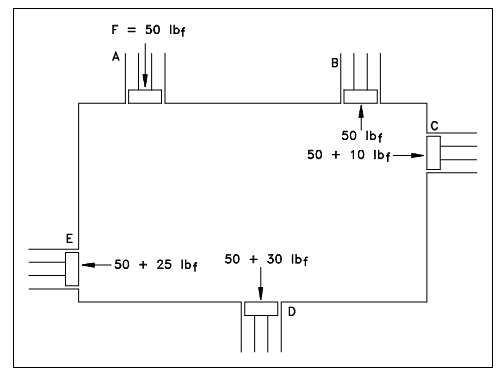Pascal's Law
The pressure of the liquids is due to the weight of the liquid. Liquid pressures might also outcome from application of exterior forces on the liquid. Consider the illustrations shown below. The figure shown below symbolizes a container entirely filled with liquid. A, B, C, D, and E symbolize pistons of equal cross-sectional areas fixed into the walls of the vessel. There will be forces performing on the pistons C, D, & E due to the pressure caused by the various depths of the liquid. Suppose that the forces on the pistons due to the pressure caused by the weight of the liquid are as follows: A = 0 lbf, B = 0 lbf, C = 10 lbf, D = 30 lbf, and E = 25 lbf. Now assume an external force of 50 lbf be exerted to piston A. This external force will cause the pressure at all points in the vessel to rise by the same quantity. As the pistons all have similar cross-sectional area, the rise in pressure will outcome in the forces on the pistons all rising by 50 lbf. Therefore when an external force of 50 lbf is exerted to piston A, the force applied by the fluid on the other pistons will now be as shown: B = 50 lbf, C = 60 lbf, D=80 lbf, and E=75 lbf.
This effect of an external force on a cramped fluid was first defined by Pascal in the year 1653.
Pressure exerted to a cramped fluid is transmitted undiminished throughout the confining container of the system.

Figure: Pascal's Law